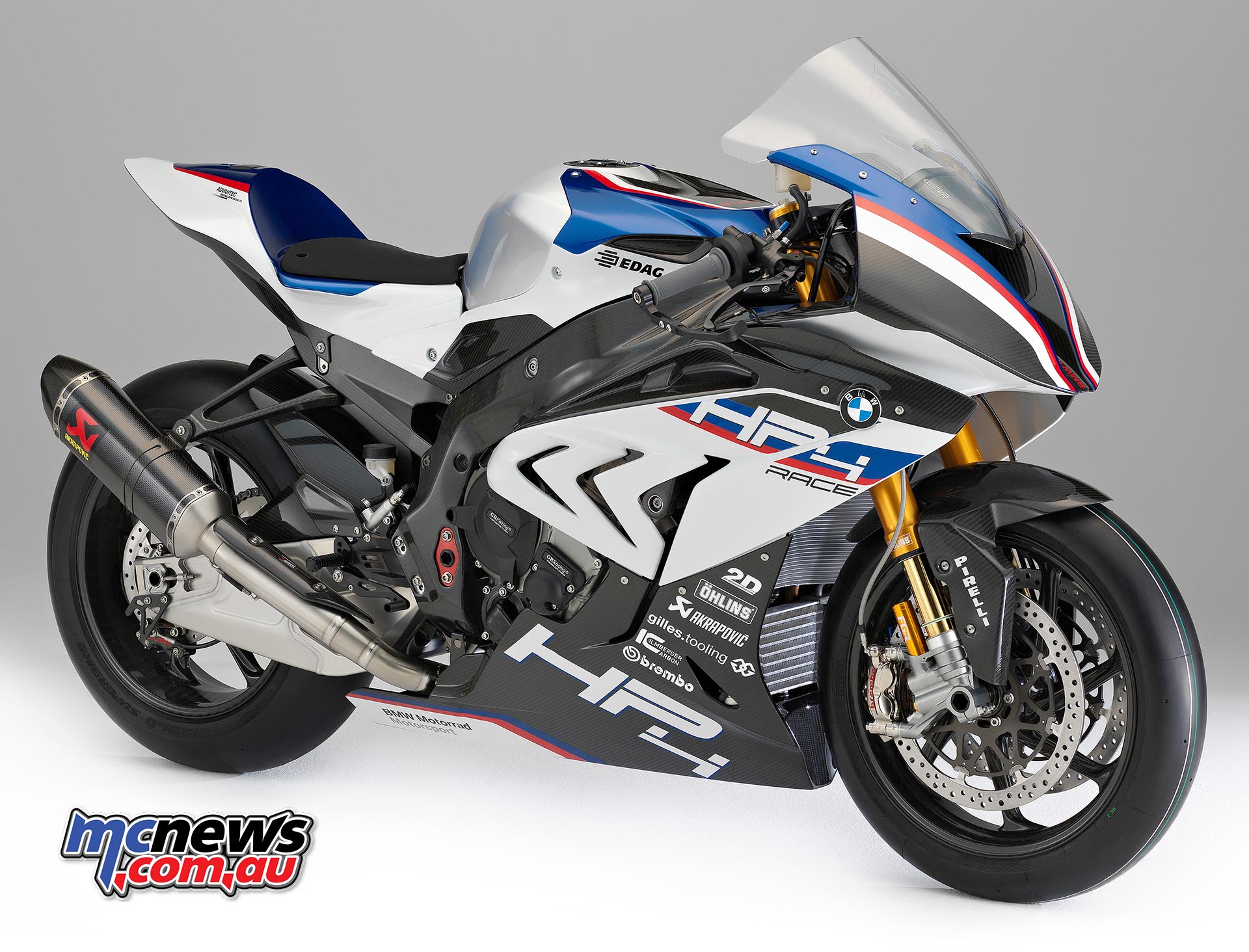2017 Honda CBR1000RR Fireblade
Last month Honda unveiled the more bespoke Fireblade SP2 and SP Fireblade models for 2017, the details of which you can find here, but it was not until overnight in Europe that Big Red unveiled the new standard edition 2017 Honda CBR1000RR Fireblade.
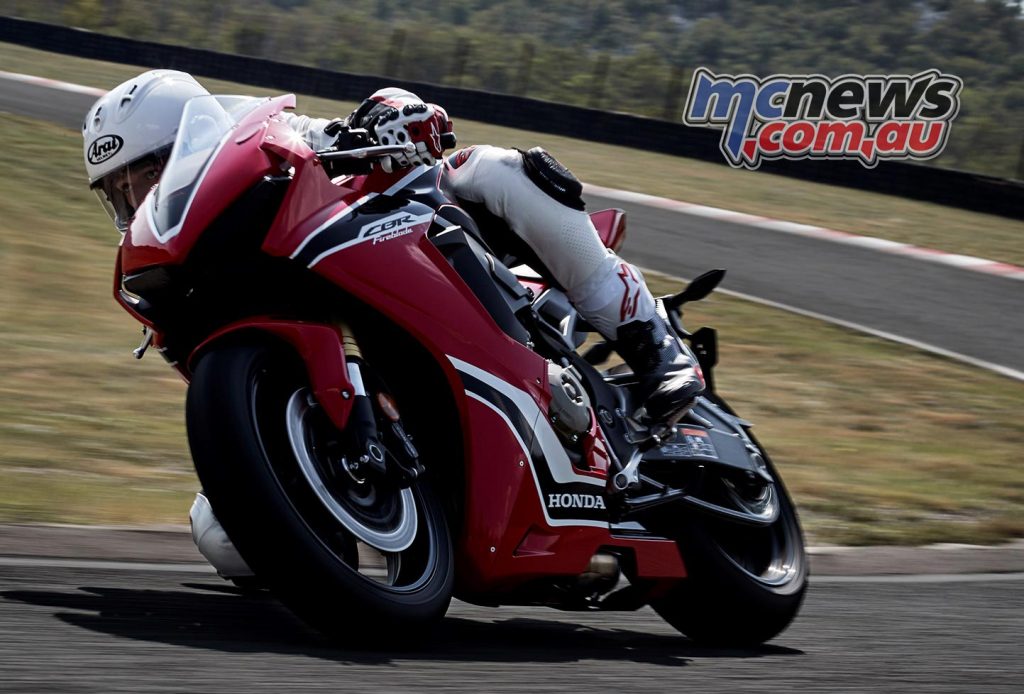
While not a massive departure from traditional Fireblade styling lines and retaining identical geometry to the outgoing model, 90 per cent of major components are all new for 2017. The 2017 Honda CBR1000RR Fireblade will arrive in Australia in May, 2017, at a RRP of $22,499.
Comparing the outgoing ABS optioned model, with the new ABS as standard equipment Fireblade, the 2017 CBR1000RR is now 15kg lighter and boasts 11 more horespower.
Honda are claiming 189hp (141kW) at 13,000rpm and 114Nm of torque at 11,000rpm, which combine with the significant weight savings to imrpvoe the power-to-weight ratio by 14 per cent.
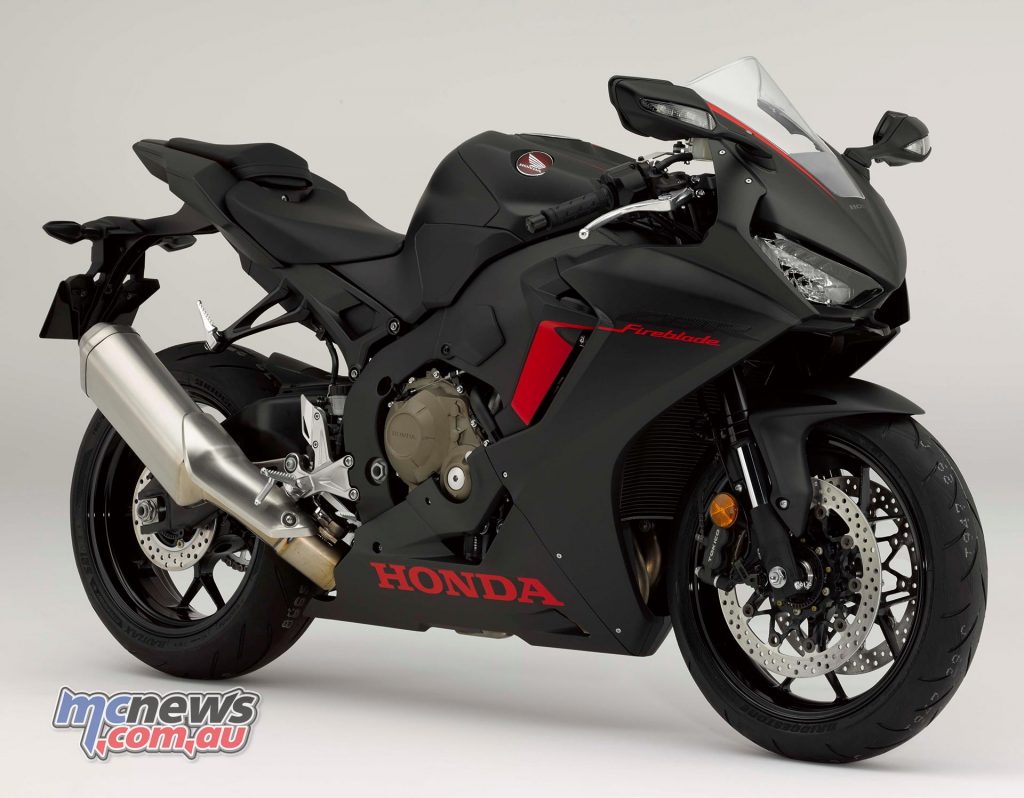
The 2017 Honda CBR1000RR Fireblade is also equipped with Honda Selectable Torque Control, Selectable Engine Brake, new ABS, Riding Mode Select System and Power Selector, full Showa suspension and RC213V-S MotoGP derived technology.
Clearly this is a massive jump forward for the Fireblade in all areas of performance that really matter. Much lower weight, a lot more power and now the full gamut of electronic aids finally making their way onto Honda’s sporting flagship, at the time when such aids have really reached maturity.
And with three models to choose from; the Fireblade, Fireblade SP, and the very limited edition Fireblade SP2 (only 20 of these machines are slated to come to Australia), Honda have a stronger sportsbike armoury than ever before.
The standard Fireblade and the Fireblade SP are expected to arrive in Australia early April but there is, as yet, no word on when when the 20 SP2 models slated for Australia will be available.
2017 Honda Fireblade Summary
- 8kW power increase
- Revised valve lift and cam timing
- Magnesium covers and detail redesign saves 2kg
- 4-2-1 exhaust with titanium muffler
- Redesigned slipper clutch
- 9 level Honda Selectable Torque Control (HSTC)
- New ABS
- Riding Mode Select System (RMSS)
- 196kg wet weight
- Showa 43mm Big Piston Forks (BPF) and Balance Free Rear (BFR) shock
- Adjusted rigidity balance for the frame
- Stiffer swingarm
- Lighter subframe
- New Tokico four-piston radial mount brake calipers
- Redesigned wheels
- Minimal and aggressively styled bodywork
- Throttle By Wire (TBW)
- Accelerator Position Sensor (APS)
- Power Selector
- Wheelie Control
- Selectable Engine Brake (SEB)
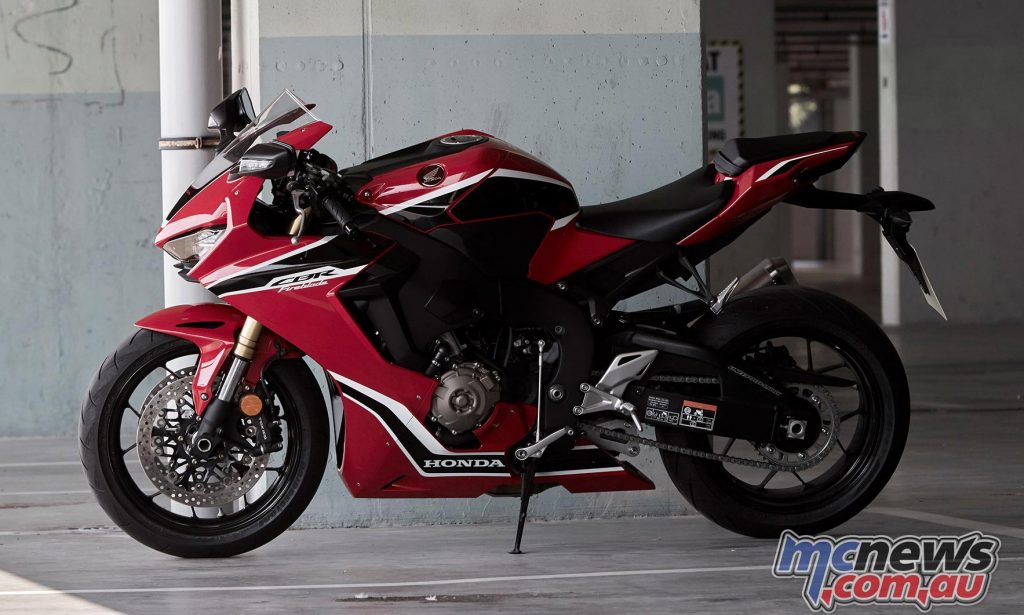
Mr M. Sato, Large Project Leader (LPL) 17YM CBR1000RR Fireblade
“All 1000cc sportsbikes are extraordinary examples of high performance engineering. But for us, for our new Fireblade we want extraordinary to be the pleasure of handling and controlling such a machine. Its true purpose – wherever it’s ridden – is to enjoy something that is not normally experienced in everyday life, something that cannot be surpassed. The very first CBR900RR remains a milestone in our history, and an inspiration we have drawn on to radically reduce weight and increase power. And, to go to Next Stage Total Control, we have added an electronic control system that is there to support the rider, totally. What then can our new Fireblade promise our customers? That is simple – the pure joy of riding.”
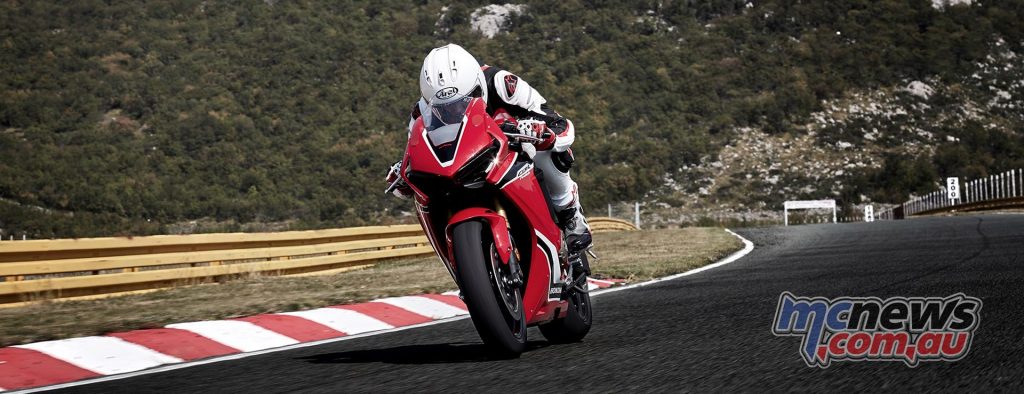
2017 Honda CBR1000RR Fireblade in Detail
Three factors are key to the essence of the new CBR1000RR Fireblade: less weight, more power, and electronics to help the rider wherever and however they’re riding.
The new electronic control system provides constant, selectable and fine-tunable rider support. Central to the system is the 5-axis Inertial Measurement Unit (IMU), which measures exactly what the machine is doing, in every plane.
It works with the Honda Selectable Torque Control system (HSTC) that precisely manages rear wheel traction via the FI-ECU and Throttle By Wire (TBW). The new ABS braking (also managed by the IMU) offers Rear Lift Control (RLC) and the ability for hard, safe trail braking into corners. Any difference measured between the front and rear wheel speeds engages Wheelie Control, depending on settings.
Three standard display modes – Street, Circuit and Mechanic – provide all the information required for the rider relevant to the type of riding. The information displayed can be fine-tuned and adjusted while riding by using the left hand switch gear and TFT liquid crystal display, just as on the RC213V-S, Honda’s road going version of its RC213V MotoGP machine.
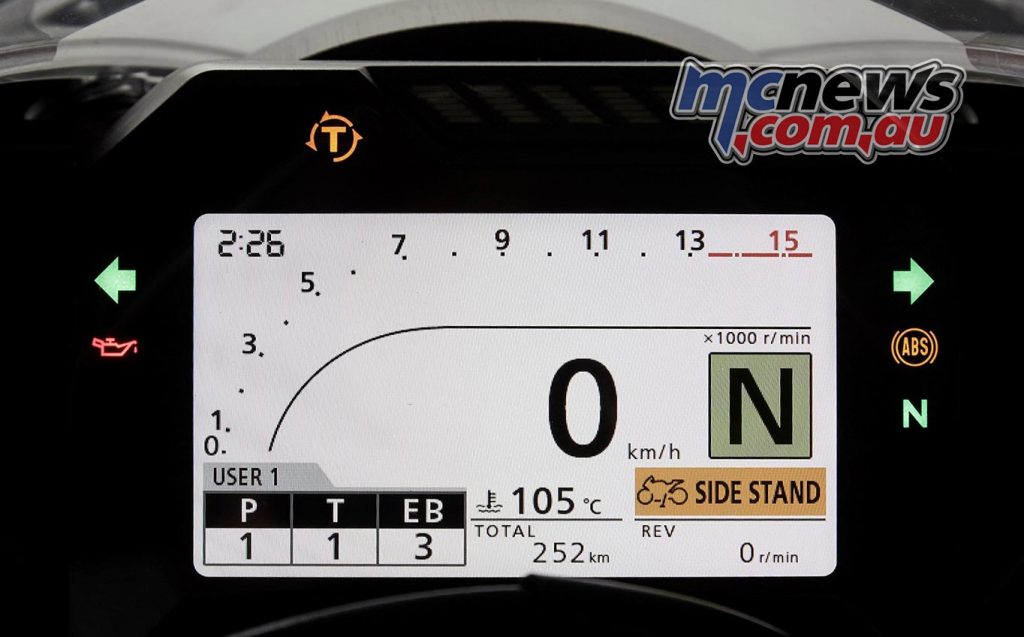
While the electronic control is very much a new departure for the Fireblade, the other two factors draw faithfully on the philosophy of the original 1992 machine: the optimal balance of power and weight. Ninety percent of the main components have been changed in a relentless search for incremental weight reduction in every area. The engine revs harder and higher, with a much higher compression ratio and revised cam timing, and uses the TBW (a first for an inline four-cylinder Honda) and Accelerator Position Sensor (APS) also developed for use on the RC213V-S.
Bottom end torque and power are improved, with a significant increase in top-end power – up 8kW to 141kW @ 13,000rpm and 3 modes of engine output character can be selected.
Thanks to the use of magnesium and careful assessment and lightening of individual parts the engine also carries 2kg less. The new titanium exhaust muffler saves weight and aids mass centralisation. Overall the Fireblade is a full 15kg lighter than the outgoing model, with a wet weight of 196kg.
The twin-spar aluminium frame’s rigidity balance has been finely adjusted, and the swingarm is stiffer to match. A new rear subframe is lighter, as are the redesigned wheels, while new Tokico four-piston front brake calipers use high-performance track-ready brake pads.
The Fireblade’s bodywork outlines an aggressive, functional minimalism, and the machine is slimmer and much more compact. All lighting is LED and two paint options – Victory Red and Matt Ballistic Black Metallic – will be available.
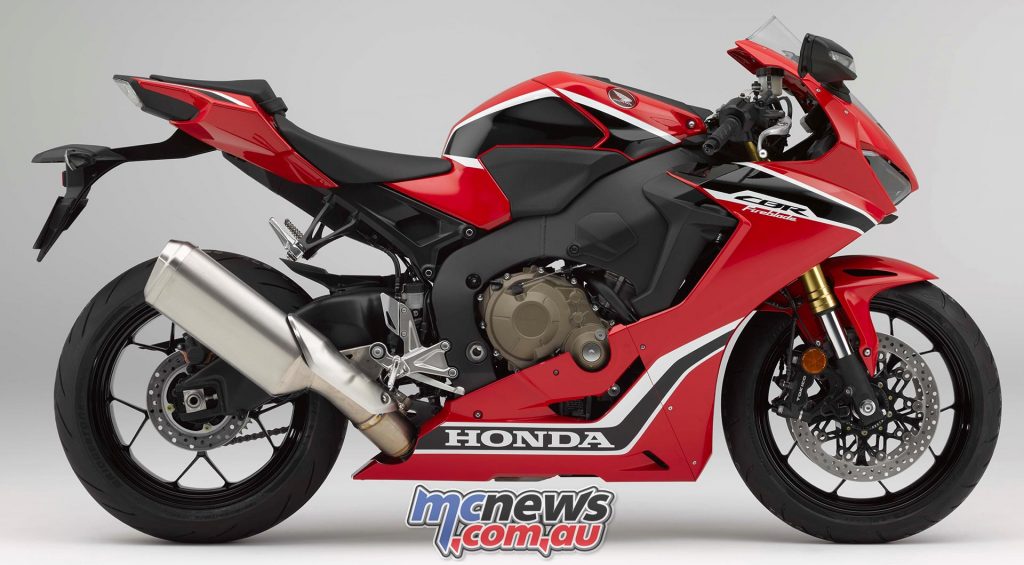
The Fireblade’s new electronic control system provides several active features that many riders will find useful. The new ABS allows extremely hard braking while maintaining rear wheel contact with the ground, stopping the tendency for the rear of the machine to elevate or ‘back in’ around the front. It uses the 2-axis acceleration information from the Inertial Measurement Unit (IMU) and calculates the acceleration of the machine’s centre of gravity in the lift direction and acceleration perpendicular to that, using the front wheel as the grounding point.
The new ABS delivers smooth, effective braking into a corner. With information from the IMU, plus front and rear wheel speed sensors, the ABS modulator controls braking force according to lean angle, even when emergency braking. But it also allows for hard trail braking by using two parameters (deceleration derived from wheel speed and front/rear slip rates) plus lean angle to vary the threshold of ABS intervention. ABS delivers an extra sense of security when braking hard on the road, and offers a performance edge in certain conditions on the racetrack.
In isolation all the functions of the electronic control system – plus the HSTC’s wheelie control – perform specific, individual tasks. When tied together, however and working seamlessly as one they provide technological rider support that truly elevates the super sports experience. Next Stage Total Control, indeed.
Like the RC213V-S the Fireblade uses a full-colour TFT liquid crystal dash to clearly communicate information to the rider. It automatically adjusts to ambient light, with a backlight of up to 1000 cd/m2 luminescence and features 3 modes: Street, Circuit and Mechanic – each with the information most relevant for that particular usage.
Street displays riding modes (1-3 and USER 1-2) plus the settings for each parameter – P (power), T (HSTC) and EB (Selectable Engine Brake). Circuit adds in addition to Street mode the lap time, number of laps and difference from the best lap. Mechanic displays the digital tacho, gear position, grip angle, coolant temperature and battery voltage.
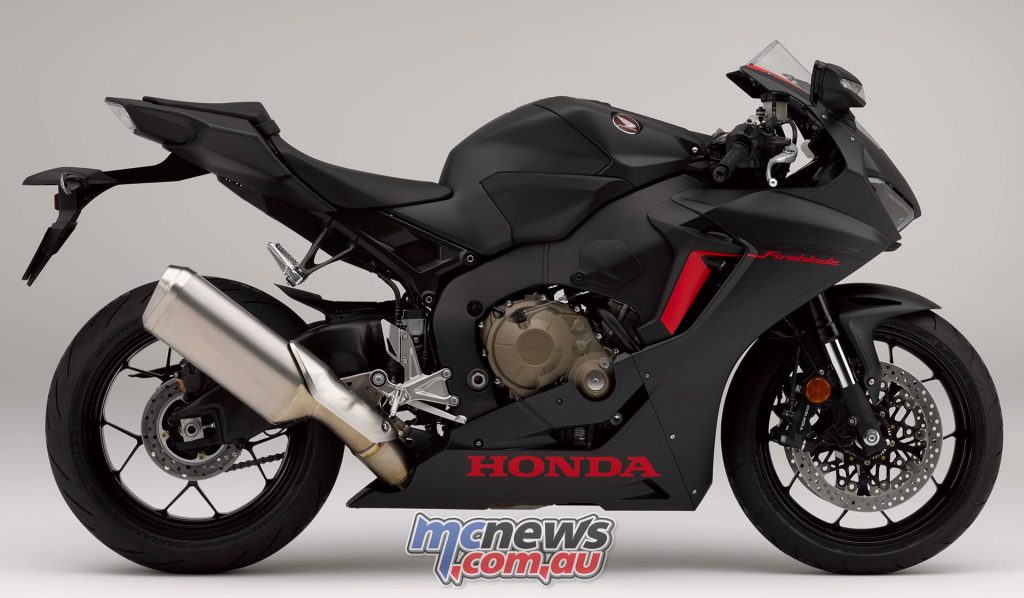
There are 3 preset riding Modes, Track (1), Winding (2) and Street (3) that offer different combinations of HSTC, Engine Power and Engine Braking level. Riding mode 1 (Track) gives full power, with linear throttle response, low HSTC and EB intervention. Mode 2 (Winding) controls output through first to third gear, with fairly moderate power increase, medium HSTC and strong EB. Mode 3 (Street) controls output through first to fourth gear, with moderate power increase, high HSTC and strong EB.
In the two USER modes all parameters can be combined and adjusted freely; riding modes and HSTC can be changed while riding by using the up/down switch on the left switch gear.
The Shift-Up indicator is a horizontal line of 5 white LEDs located at the top; when engine speeds exceed user presets they go from solid to flashing. Displays include speedometer, tachometer, gear position, coolant temperature, riding distance and twin trip meters.
The onboard computer calculates instantaneous and average fuel economy, trip fuel consumption, average speed and time after last ignition, plus remaining fuel after reserve light and distance to empty (when selected). This information is shown on the bottom right of the screen.
In the upper display, middle right the rider can choose to see the Shift-Up indicator setting speed, grip angle, battery voltage, calendar, or user-defined text.
Switching between modes is controlled by a mode switch on the right of the left hand switchgear. Just above it is an up/down switch that manages and changes the information displayed within the mode.
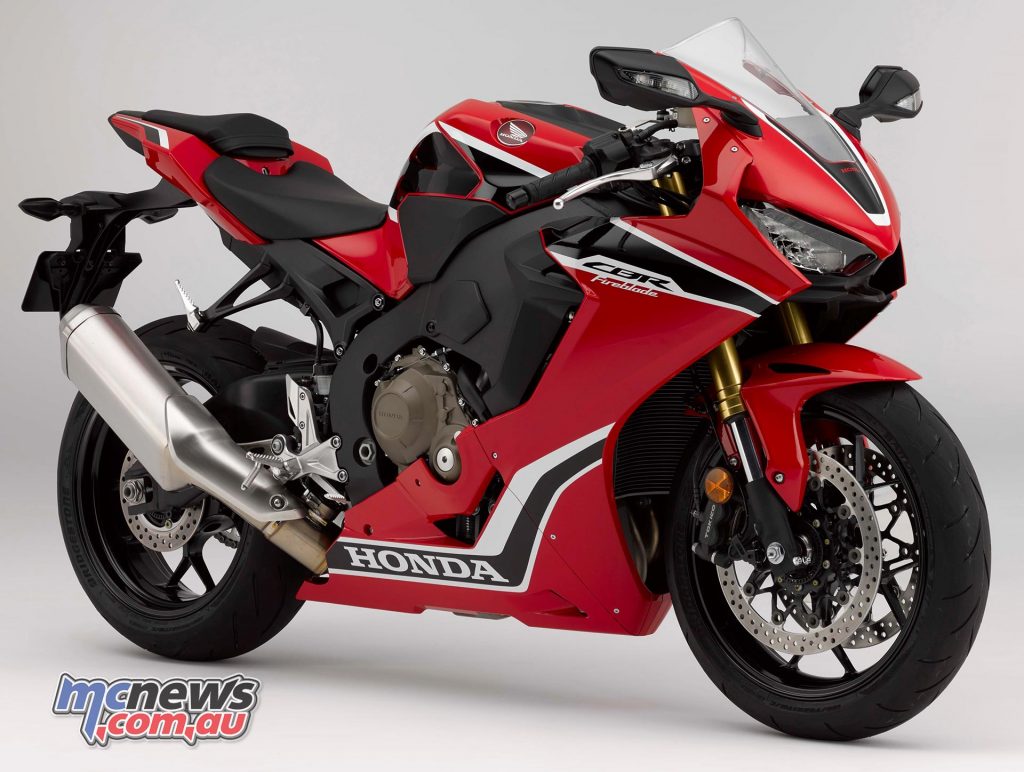
2017 Fireblade Chassis
As a machine now a full 15kg lighter – with a wet weight of 196kg –the Fireblade’s physical handling has also been transformed. Rake and trail remain 23 °20’ / 96mm but the hollow die-cast twin-spar aluminium frame’s rigidity balance has been significantly adjusted to give even sweeter handling with outstanding steering response, feel and stability.
Thinned frame walls save 300g. While transverse rigidity is unchanged, the frame is 10% more flexible in the torsional plane, which works to deliver a faster-reacting chassis. Yaw moment of inertia has been reduced by 15%; roll moment of inertia by10%. The Honda Electronic Steering Damper (HESD) unobtrusively maintains stability.
To complement the frame changes the aluminium Unit Pro-Link swingarm’s hybrid structure has had the thickness of each section adjusted, saving approx. 300g while maintaining transverse rigidity and increasing torsional rigidity.
The Showa 43mm BPF inverted telescopic fork with its large damping volume effectively reduces hydraulic pressure generated under compression and extension. This results in reduced play during the initial stroke and smoother damping, maximising tyre contact with the tarmac. Spring preload and rebound/compression damping are fully adjustable.
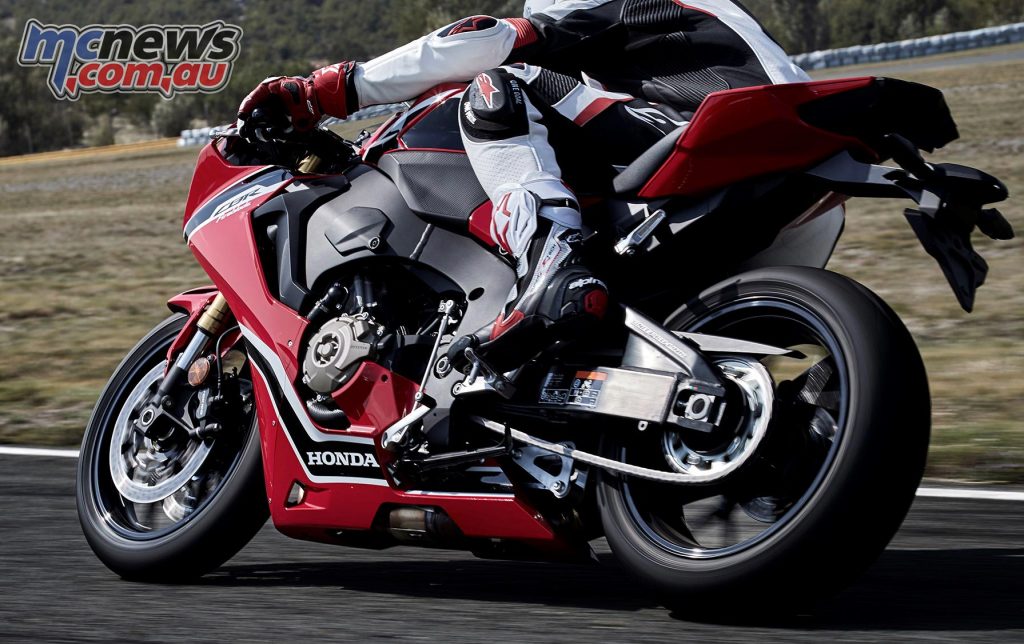
The rear suspension features a fully adjustable Showa Balance Free Rear Cushion (BFRC). Instead of a conventional single-tube layout, BFRC uses a double-tube design: the damper case and an internal cylinder. The damper piston has no valves – instead the damping force is generated as displaced oil passes through a separate damping component.
This allows pressure changes within the shock to be smoothly controlled. And because there are no small amounts of oil being used at high pressures, damping response and reaction are improved, and damping force can function smoothly during load input. Moreover, damping weight is generated consistently when switching from rebound to compression due to even pressure changes.
The die-cast aluminium subframe too has been redesigned and its thinner construction is at the same time highly rigid and 600g lighter – contributing to the concentration of mass and thus neutral handling feel with improved agility. Wheelbase is 1405mm; seat height is 832mm.
New front Tokico four-piston opposed radial mounted brake calipers are highly rigid, 150g lighter and do without hanger pins. Newly-developed high-mu (coefficient of friction) brake pads are fitted – these have a greater performance parameter at higher temperatures than standard pads. The aluminium wheels are a new five Y-shape design, saving approx. 100g. Tyre sizes are 120/70 R17 front and 190/50 R17 rear.
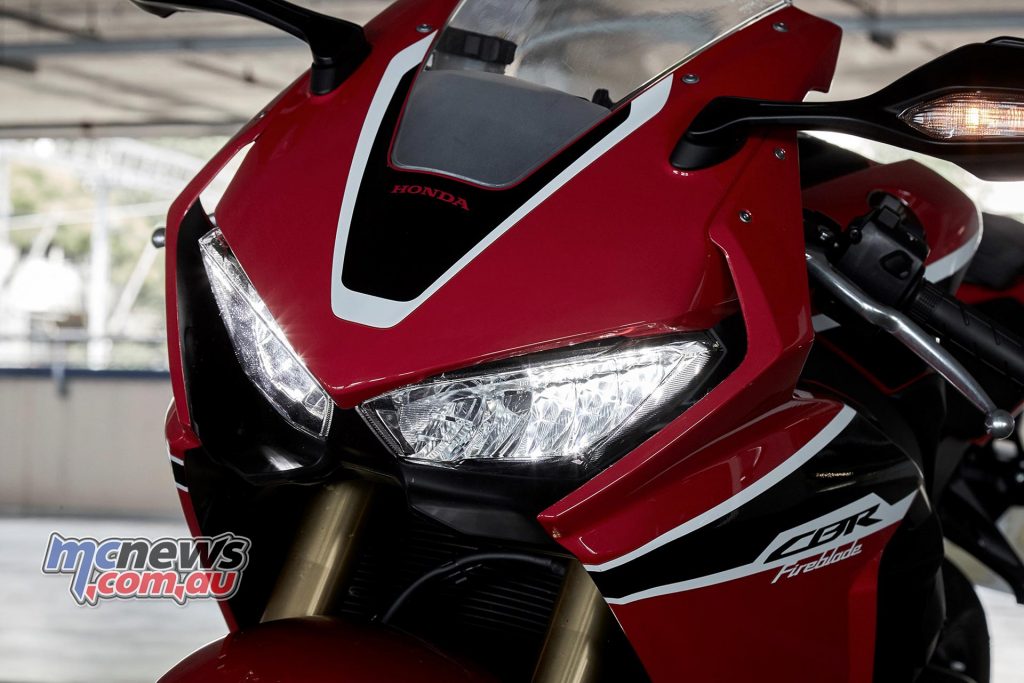
Minimal and dynamic are two words used to best describe the Fireblade’s new styling. The design team wanted to create tightly compact proportions and the upper and middle fairing surfaces have been reduced in size as far as possible. Forward tilting character lines inject an aggressive attitude, with a focus on mechanical functionality, detail and quality of finish.
24mm in width has been squeezed from the upper fairing. Airflow control from the flow surfaces of the fairing, to the surface angle of the headlights and the contouring of their side slits supports stability at speed. In a racing crouch the rider is tucked well out of the airstream. In normal riding situations air pressure is evenly distributed on the rider’s shoulders, back and sides.
18mm has been saved across the middle fairing and its ‘knuckles’ double as radiator intake structures that pass discharged air around the outside, and underneath, the rider’s legs. The knee grip area is 15mm per side slimmer, with the interface between tank cover and the seat unit athletically accentuated.
All lighting is crisp LED, with the twin front headlights offering high/low beam on both sides. Crowned with a sharply angled new logo the Fireblade will be available in two paint options: Victory Red and Matt Ballistic Black.
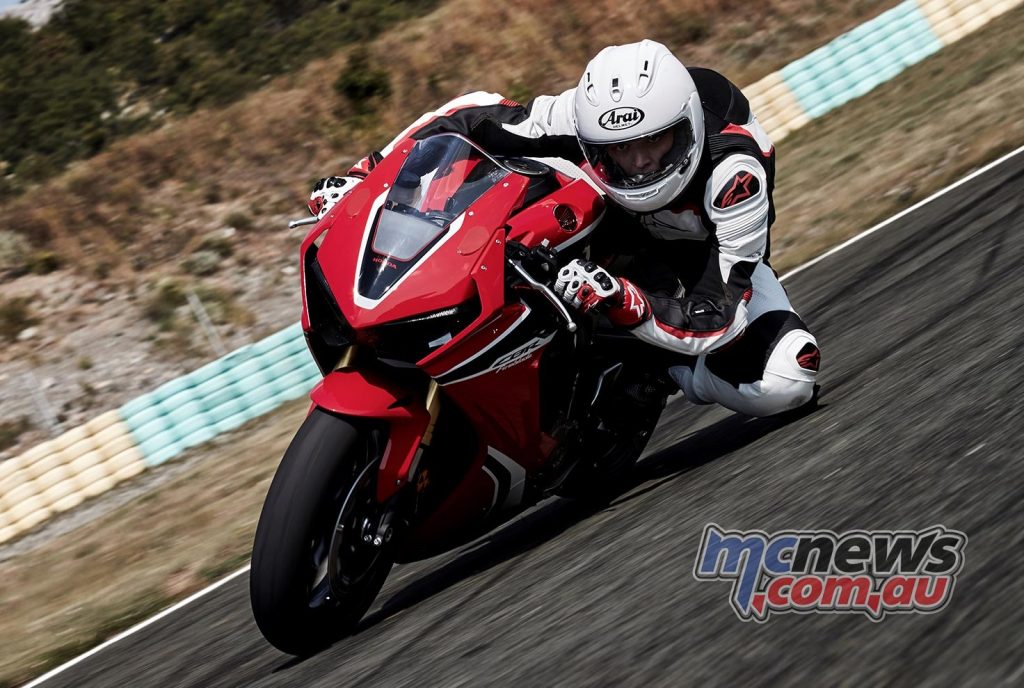
2017 Fireblade Electronics
The 17YM Fireblade is the first inline four-cylinder engine from Honda to use Throttle by Wire (TBW) control. Derived and developed from the system used by the RC213V-S, its job is to put precise throttle control – and a very natural feel – in the rider’s right hand.
Heart of the system is a newly developed throttle grip Acceleration Position Sensor (APS) integrated into the right handlebar switchgear, which itself neatly mounts the engine start/stop switch – nothing more. APS converts movement of the grip into an electrical signal sent to the ECU, that then transmits it as an actuator signal to the TBW motor, achieving ideal throttle control relative to grip angle.
The return spring and other mechanisms inside the APS faithfully reproduce the initial play and feel of a cable, with throttle load set specifically for the Fireblade. Throttle bore is increased 2mm to 48mm (without increasing exterior width) and careful shaping of the intake funnels adds to the linear throttle response.
The Power Selector can be accessed through the RMSS. It offers 5 levels of output character: Level 1 give peak output in all six gears; Level 2 output is controlled in each gear to achieve smooth throttle feel under acceleration or deceleration; Level 5 has the strongest output control for most moderate throttle response. All levels have the same throttle response on initial opening.
Riding Mode (1) uses Level 1 as its preset, drawing out the full performance of the engine. Mode (2) uses Level 2, and is suitable for twisty roads and city environments, while Mode (3) goes to Level 5 for maximum security. Individual rider preferences can also be input manually through the USER 1 and 2 interface.
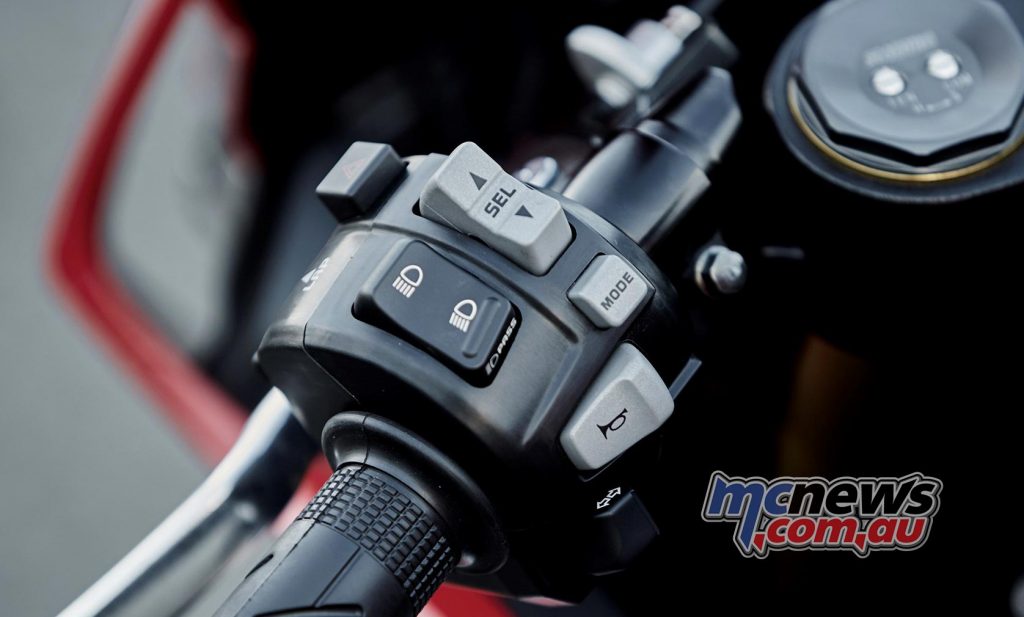
The Fireblade employs an enhanced version of the Honda Selectable Torque Control (HSTC) used on the RC213V-S. It controls engine torque via two sensing methods – the first uses wheel speed sensors to measure and compare front and rear wheel speeds. When the FI-ECU detects rear wheel acceleration (and front wheel deceleration) it reduces the TBW throttle position, and thus output, keeping the front wheel on the ground. Maximum application of the throttle is thus possible without fear of wheelies, with 3 levels of Wheelie Control, plus off.
The second sensing function detects machine roll angle. The IMU located under the seat detects rotational speed in the chassis’ roll and yaw directions, and acceleration in the longitudinal, lateral and vertical directions. It then calculates roll angle to control engine torque, maintaining rear wheel traction at the required level. The body roll calculation logic used by the ECU uses the same attitude detection technologies developed for Honda’s ASIMO humanoid robot, enabling the most precise calculation possible.
Nine intervention levels (plus off) are offered by HSTC to suit rider preferences, and the Riding Modes USER 1 and 2 enable individual changes to be made while moving.
There is also a Selectable Engine Brake (SEB) system to change engine-braking character to match rider preference and a range of conditions. Level 1 offers the highest braking force, Level 3 the lowest. The preset Modes 1, 2 and 3 use recommended settings, but through USER 1 and 2 can be set individually.
A Quickshifter with Downshift Assist system (as fitted to the CBR1000RR Fireblade SP1) is available as an optional extra.
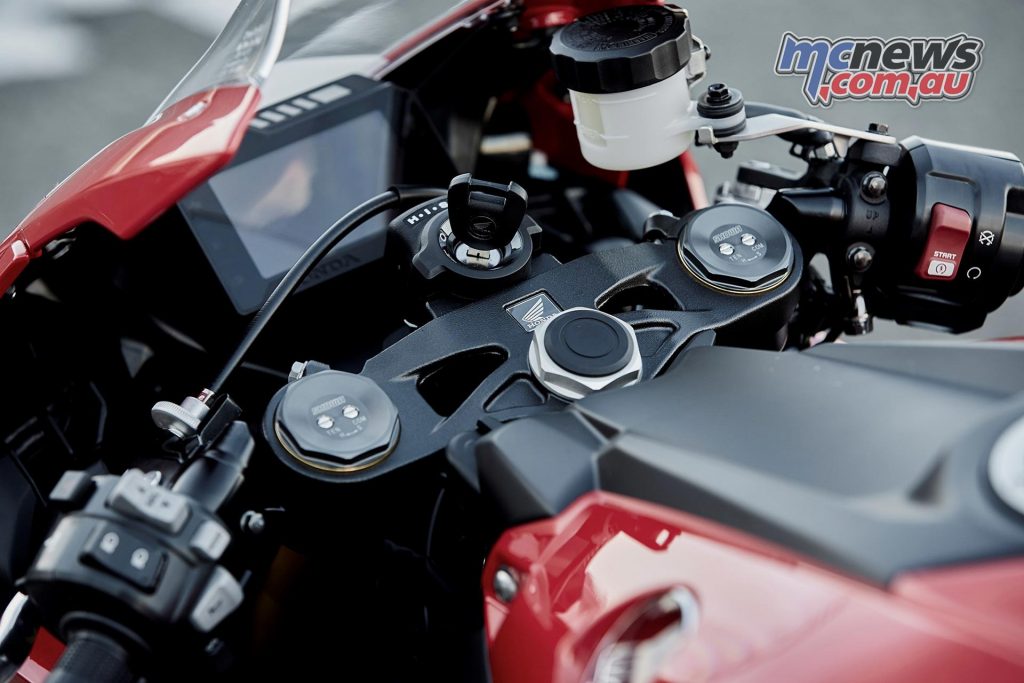
2017 Fireblade Engine
Honda’s engineers exhaustively re-examined the Fireblade’s 999.8cc inline four-cylinder engine to make it as light and powerful as possible. The result of the work is an extra 8kW, the loss of 2kg and raised rev ceiling of 13,000rpm.
Peak power is 141kW @ 13,000rpm, with peak torque of 114Nm delivered @ 11,000rpm. Bore and stroke remain 76 x 55mm but compression ratio is up from 12.3:1 to 13:1. This is an engine in a very high state of tune and the crankshaft, valve train and transmission all use higher specification materials than the previous design.
The pistons feature an optimised wall thickness and a new crown design to raise the compression; the surface finishing of the piston-ring grooves has also been modified to improve sealing performance and efficiency. Valve lift and cam timing has been revised to match the higher rpm and greater engine performance.
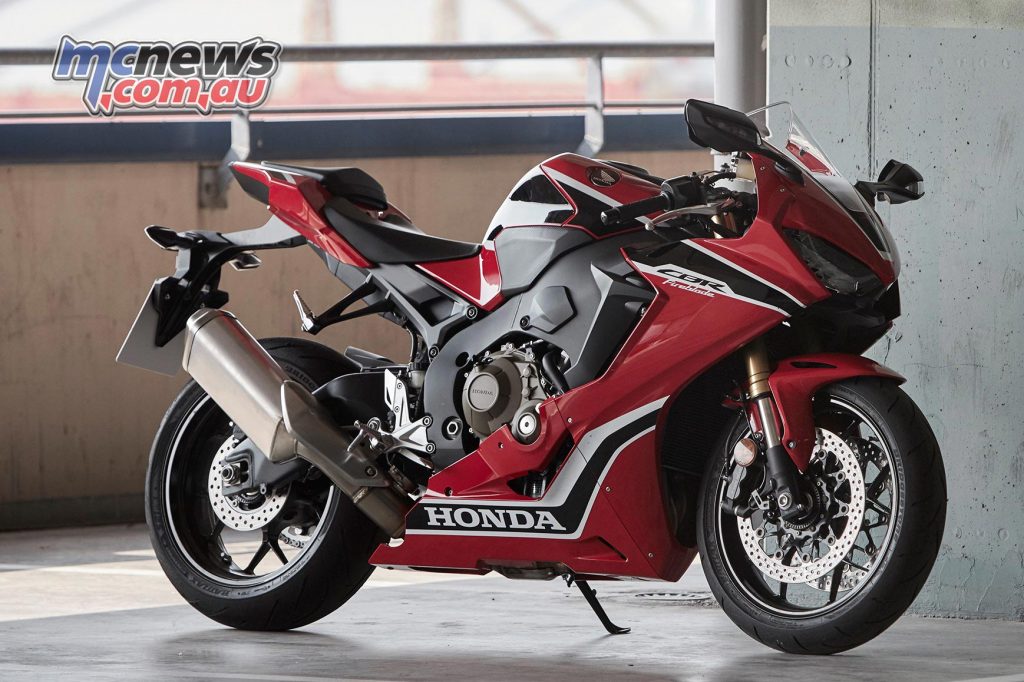
Power up is just one part of the Fireblade’s story – reduced weight is another. So every part of the engine was scrutinised to see if it could be made lighter. All the engine covers are redesigned (clutch cover is aluminium; the ignition cover magnesium) and the length of the bolts, water hose and water hose bands have been reduced.
With a revised, rounded shape the radiator is 30mm narrower in overall width and 100g lighter (including a 30cc reduction in water capacity). Using a new high-density core it achieves identical heat dissipation and contributes to the slimmer frontal area of the fairing cowls.
The assist slipper clutch is completely revised with a single die-cast pressure plate and clutch centre, and offers reduced load at the lever. For downshifts the slipper functionality remains the same as before but aluminium cam parts (instead of steel) save weight. The gap between the accelerating and decelerating cams has also been optimised, again improving lever feel when changing gear. All of the transmission gears have been pared down to save weight.
The titanium irregular cross-section muffler is 2.8kg lighter and minimises the centre of gravity change; it also creates an unmistakable sound tone from the exhaust on an open throttle. The exhaust supplier to the Honda Repsol MotoGP team was asked to develop the prototype and produced an exquisite design with the 4-2-1 double-skinned downpipes incorporating the exhaust valve within the first main pipe.
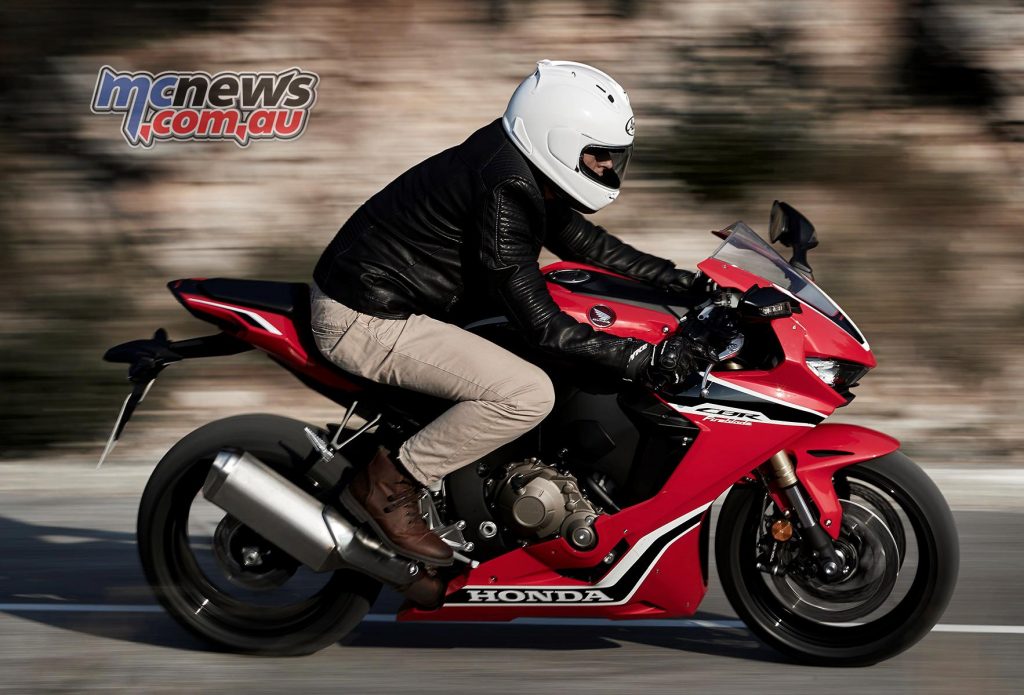
2017 Honda CBR1000RR Fireblade Technical Specifications
| ENGINE | |
| Type | Liquid-cooled 4-stroke 16-valve DOHC Inline-4 |
| Engine Displacement (cm³) | 999cc |
| No. of Valves per Cylinder | 4 |
| Bore ´ Stroke (mm) | 76 x 55 |
| Compression Ratio | 13:01 |
| Max. Power Output | 141kW/13,000rpm |
| Max. Torque | 114Nm/11,000rpm |
| Oil Capacity | 3.4L |
| FUEL SYSTEM | |
| Carburation | PGM-DSFI |
| Fuel Tank Capacity | 16L |
| Fuel Consumption | – |
| ELECTRICAL SYSTEM | |
| Starter | Electric |
| Battery Capacity | 12V-7AH(Li-ion) |
| ACG Output | 0.42kw |
| DRIVETRAIN | |
| Clutch Type | Wet, multiplate with diaphragm spring with assist slipper |
| Transmission Type | 6-speed |
| Final Drive | Chain |
| FRAME | |
| Type | Diamond; aluminium composite twin spar |
| CHASSIS | |
| Dimensions (L´W´H) | 2,065mm x 720mm x 1125mm |
| Wheelbase | 1405mm |
| Caster Angle | 23°20’ |
| Trail | 96mm |
| Seat Height | 832mm |
| Ground Clearance | 130mm |
| Kerb Weight | 196kg |
| Turning radius | – |
| SUSPENSION | |
| Type Front | Telescopic inverted fork with an inner tube diameter of 43 mm, and a Big Piston Front Fork with preload, compression and rebound adjustment, 120mm stroke |
| Type Rear | Unit Pro-Link with gas-charged HMAS damper featuring 10-step preload and stepless compression and rebound damping adjustment, 138.2mm stroke. Rear Balance Free Rear Cushion with preload, compression and rebound adjustment, 62mm stroke. |
| WHEELS | |
| Rim Size Front | 17 inch |
| Rim Size Rear | 17 inch |
| Tyres Front | 120/70ZR17 58W |
| Tyres Rear | 190/50ZR17 73W |
| BRAKES | |
| ABS System Type | 2 Channel |
| INSTRUMENTS & ELECTRICS | |
| Instruments | TFT-LCD |
| Security System | HISS |
| Headlight | LED |
| Taillight | LED |
All specifications are provisional and subject to change without notice.
[youtube id=”aBT9qm4lX3I” width=”560″ height=”315″]






